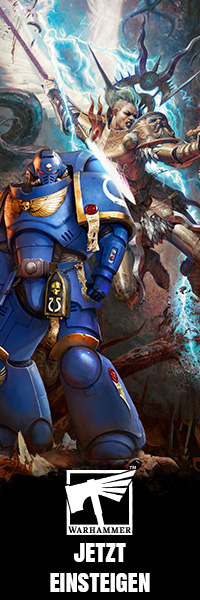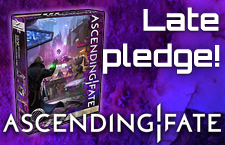Myth & Goal: Design Diary 2
Und weiter geht es mit den Previews zu Myth & Goal.
Myth & Goal – Design Diary 2: Teams & Players
Hey, welcome back!
James from Needy Cat Games here again, to share some more thoughts about the design and development of Myth & Goal. If you missed part 1, you can find it here – I’d recommend giving it a read before you dive into this one, so you’ve got an overview of how the game works.
In this diary, I’m going to be looking at Teams and Players in a bit more detail. Last time I mentioned how a Team is made up of a Faction (which Players it includes) and a Focus (how it plays on the field), but let’s see how that actually works.
TEAMS & FACTIONS
In the Myth & Goal box, you’ll find four distinct Faction sets (the Durnhold Anvils, the Belhurst Imperials, the Westarch Ruffians and the Athrian Sapphires), each of which consists of a Faction Card, eight Player Cards and eight Player Miniatures. That means that whenever you choose the Durnhold Anvils team, you’ll be using the same eight players – the Factions each have their traditional mix of Player classes (more on those in a minute) which suit their overall play style.
The Durnhold Anvils
Once you’ve chosen your Faction, you tweak how your team plays by choosing a Focus Card – maybe your team’s Mighty, or Versatile, or Devious. This doesn’t affect the Players available to your team, but it gives you a special rule which can seriously impact your team’s capabilities. Your Faction and Focus also determine the cards in your Tactics Deck, and how your team advances during League Play, but we’ll be talking about those things in a later diary entry! The key point is that although a Durnhold Anvils team always uses the same mix of Player Classes, they don’t all play the same.
Some Tactics cards
That’s the second time I’ve mentioned Player Classes, so I’d better explain what they are.
CLASSES & PLAYERS
In the background, over the many years that Mythball’s been played, a number of traditions have sprung up – and one of these is the Class system. When a new recruit joins a team, they’re assigned a Class based on their skills and strengths, and this will determine the focus of their training and development for the rest of their career. In the game, a Player’s Class gives both Managers (the people playing the game) a quick way of knowing the rough capabilities of a Player from either team.
There are six Classes in the game:
- Chargers are brutal powerhouses who specialise in tackling enemy Players.
- Strikers are skilled players who have a good eye and a strong throwing arm.
- Vanguards use speed and agility to zip past the opponent’s defence and receive the ball.
- Sentinels are all-rounders who are at their best when supporting other players on the team.
- Guardians are backfield workhorses, usually to be found defending their Gatehouse.
- Rangers specialise in running the ball upfield, or recovering it from the enemy team.
The first three classes tend to be a bit more flashy than the second three, but a shrewd Manager will put all of the Players on their team to good use – the Fatigue and Infraction systems mean that you can’t just rely on a handful of your best and brightest!
Eagle-eyed readers will notice that the Classes draw some parallels with Player Positions in other popular fantasy football games. This is intentional, and stems from the fact that the miniatures are designed to be used in such games as well as in Myth & Goal. Constraints like this always make for an interesting game design puzzle, and we had a whole bunch of emails flying back and forth in the early days of the project as we figured out how we’d make this work for various different teams. It was important to nail this from the outset.
As well as a miniature, each Player on a team has a corresponding Player Card. During a Period of play, you’ll have five of your Players on the field at once, and their Player Cards will go into the Squad Slots along your edge of the board. The remaining three Players will be Benched, with their cards off to the side of the board. A Player Card contains all of the information you need to know about the Player, so you can see it all at a glance without having to look anything up in a rulebook or on a roster. Let’s take a closer look at that information!
Front side of a player card (left) and its „exhausted“ side (right)
Top left, you’ll see the Player’s Faction Badge, which tells you which Faction they belong to.
Below that, you’ve got their four Ability Ratings: Power, Agility, Skill and Resolve. These are used in Action Tests – more on those in a future diary, but the higher the number, the more dice you’ll get to roll, and the more likely you are to succeed—or to prevent your opponent from succeeding.
On the right, there’s the Player’s Speed – how many Areas they can move in a Run action – and their Fatigue Limit. Fatigue is one of the most important concepts in the game, so I’ll explain it in a bit more detail shortly.
At the bottom of the card you’ll find the player’s Class, as well as a special rule. This rule is specific to the player’s Faction and Class, so all Durnhold Anvils Sentinels (for example) have the same special rule. This might be an ongoing bonus, or it might be a unique action that other Players can’t make.
Fatigue & EXHAUSTION
In a later diary I’ll talk more about Actions, but for now, all you need to know is that there are around half a dozen different actions which all Players can make. Run lets your Player move around the field, Throw lets them throw the ball, and Stand Up… well, the action names are deliberately very straightforward, so they’re easy to remember. During your Turn, you can make up to four Actions with the Players on your team; you can spread these between your Players, or have a single Player make them all. The only hard limit is that a Player can’t make the same Action more than once in a turn.
Whenever a Player makes an Action, you place a Fatigue token on their card. If this would mean that they now have more Fatigue Tokens than their Fatigue Limit, you instead remove all Fatigue Tokens and flip their card over, revealing its Exhausted Side.
Front side of a player card (left) and its „exhausted“ side (right)
The Exhausted side of a Player Card echoes the front, but the Ability Ratings are often a bit worse, and the special rule is entirely gone. What’s more, if an Exhausted Player would be Exhausted again, they collapse and take no further part in the game. That’s a huge penalty, so a wise Manager won’t let their players get Exhausted unless they can really help it. This often leads to tough decisions, especially when Fatigue can be applied in other ways (for example, when your Player is targeted by a Tackle, you might have the option of giving them Fatigue or placing them Prone). What’s more, a Player can only recover from Exhaustion while they’re on the bench, meaning they’ll usually have to sit out an entire Period before they’re back on top…
Right! That’s more than enough for one diary entry. Come back next time to hear about those Actions in more detail – I’ll also talk about how dice rolls work, and reveal the oh-so-addictive Gambit Die. (You’ll find yourself cursing it, then cursing yourself for using it again…)
Myth & Goal is coming to Kickstarter on September 21, so make sure to sign up for updates and previews by visiting the Myth & Goal page so you’re the first to know once we launch!
Also, make sure to follow Blacklist Games on Instagram to see the premiere of many exciting character art and miniature previews!
Quelle: Myth @ Goal










Der Team Manager Aspekt liest sich richtig gut…das hat mir bei Guild Ball gefehlt. Nur die PVC Figuren dazu bräuchte ich nicht. Wenn es einen pledge nur mit Regelbuch/Karten/Spielbrett gibt, bin ich vlt dabei
Wenn es pvc minis hat kommt es bestimmt wieder von einem der alles drin china Hersteller.
Und da pvc püppies billig sind gibts dann ordentlich strech goals mit freebee…
Ich befürchte auch, das meine Chancen dafür nicht besonders groß sind. Aber ich habe mehr als ausreichend Blood Bowl Figuren(manche Teams komplett gemalt), da will ich mich gar nicht mit PVC rumärgern wollen. Da produzieren ich eigentlich nur Plastikmüll damit.
Und ich bin sicherlich nicht ganz alleine mit einer großen Sammlung Fantasy-Football Figuren…vlt würde es sich wirklich für den Hersteller lohnen 2 Box-Versionen anzubieten
Je nachdem was es denn kostet dann dennoch mitmachen und die Püppies veräußern. Mir macht es nix aus noch mehr Fantasy Football Minis zu haben. Wenn die in der Qualität in etwa so sind wie ich es von Blacklist Games kenne, dann werden sie schon recht gut werden.
Gibt es irgendwo aussagekräftige Bilder von den Minis des Herstellers? Die meisten KS von dem sind ja noch in der Auslieferung, daher habe ich noch nicht wirklich viele aussagekräftige Bilder gefunden
Ich habe Altar Quest und die Fantasy Series 1 daheim und kann eigentlich nichts schlechtes über die Qualität der Minis sagen. Bei BoardGameGeek hat es ein paar Bilder von Altar Quest und deren Minis:
https://boardgamegeek.com/image/4638246/altar-quest
Ihr habt ja vielleicht das Ontabletop Interview mit James gesehen. Er ist ziemlich stolz auf die SoloRegeln, was eine schwierige Aufgabe ist/war.
Da bin ich mal sehr gespannt drauf.